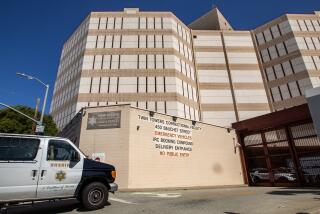National commission says prison inmates, guards should be among first to get COVID-19 vaccine

- Share via
With cases of COVID-19 continuing to spread through prisons, guards and inmates should be among the first to receive vaccinations against the virus that causes the illness, a national commission recommended Monday.
The vaccine recommendation by the National Commission on COVID-19 and Criminal Justice, whose members include former U.S. Attys. Gen. Loretta Lynch and Albert Gonzales, was the main takeaway in a set of findings released by the panel. The group also called for an increase in the number of prisoners released during the pandemic and for some incoming inmates to be diverted from prisons in order to slow the spread of the disease.
As officials in California and other states scramble to devise plans for dispersing the vaccine and which people should be the first to receive it, the commission recommended that inmates and correctional staff be put in a category behind only healthcare workers and highly vulnerable populations such as the elderly living in nursing homes.
California officials on Monday said a decision had not yet been made on where inmates will fall on the state’s vaccination plan.
Former Los Angeles Police Chief Charlie Beck, a member of the commission, said he was not part of the sub-group on prisons, but said he understands the reasoning for the recommendation, given the high-risk nature of infection while in custody.
About a quarter of inmates in California — roughly 26,000 people — have become infected with the coronavirus that causes COVID-19. Ninety-five of them have died. One of the worst outbreaks occurred at San Quentin State Prison, where more than 2,200 inmates were sickened and 28 people died during the summer. The infection rate of incarcerated people statewide skyrocketed 130% last week.
The federal prison system will be among the first to get the vaccine, but those receiving it will be staff as opposed to inmates, according to a federal memorandum initially obtained by the Associated Press.
The 14-person commission, created by the Council on Criminal Justice, found that the population density of prisons and jails, along with a lack of preparedness and guidance from justice system leadership, led to widespread failure to prevent the spread of the virus and led to numerous deaths.
Nationwide 12.7% of prison inmates have confirmed COVID-19 cases, three to four times that of the general population. Three states — South Dakota, Arkansas and Kansas — report that more than 40% of their prison populations have been infected.
In addition to the vaccine, the commission found that to increase the resiliency, fairness and effectiveness of a system that includes 2.1 million people behind bars and an additional 4.4 million on probation or parole, leaders must thin incarcerated populations to limit contact and maximize the distance between individuals.
The commission recommendation follows efforts out of California courts, where judges have ordered more than 1,000 inmates released or transferred to reduce San Quentin’s prison population of 2,900 and Orange County’s sheriff was ordered to slash his jail population.
“Fundamental changes often follow a crisis ... so as we work to improve the fairness and effectiveness of our criminal justice system, this is the time for us to be bold in our thinking and actions,” said commission co-chair Gonzales, who served as attorney general under President George W. Bush. “Let’s take this moment to make transformative, enduring improvements for the benefit of all Americans.”
Commissioners called for creating effective “safety valve” release mechanisms for medically vulnerable people in prison.
California prison officials say they have reduced the inmate statewide population by 22,000 since March, bringing it to its lowest number in three decades. But more elderly and medically vulnerable inmates have died than have been released, according to a Times analysis.
Gov. Gavin Newsom has released more than 7,400 inmates who had only a few months remaining on their sentences and left more than 8,000 inmates who were due to begin prison sentences stockpiled in county jails — passing the burden to the state’s sheriff’s departments. But lawyers for inmates say about 8,000 inmates, if not released, could be hospitalized or die if they contract the disease.
Commission co-chair Lynch, who served as attorney general under President Obama, said “it is our collective responsibility to not just tame this pandemic, but to use knowledge acquired through our journey to remedy inequities and other problems that have plagued the system for far too long.”
The body is also seeking to divert people with mental health and substance abuse disorders from custody and into public health alternatives and reduce jail populations by the use of citations in lieu of arrests for incidents that do not pose a threat to public safety.
The commission said law enforcement leaders need common standards for crisis response, to prevent the patchwork of measures used so far with COVID-19.
“As the pandemic enters its tenth month, rates of COVID-19 infections and deaths in prisons and jails continue to rise — and substantially outpace rates for the general population,” said Thomas Abt, the commission’s director. “This sobering reality is reflected in the Commission’s recommendations, which offer a roadmap forward.”
More to Read
Sign up for Essential California
The most important California stories and recommendations in your inbox every morning.
You may occasionally receive promotional content from the Los Angeles Times.











